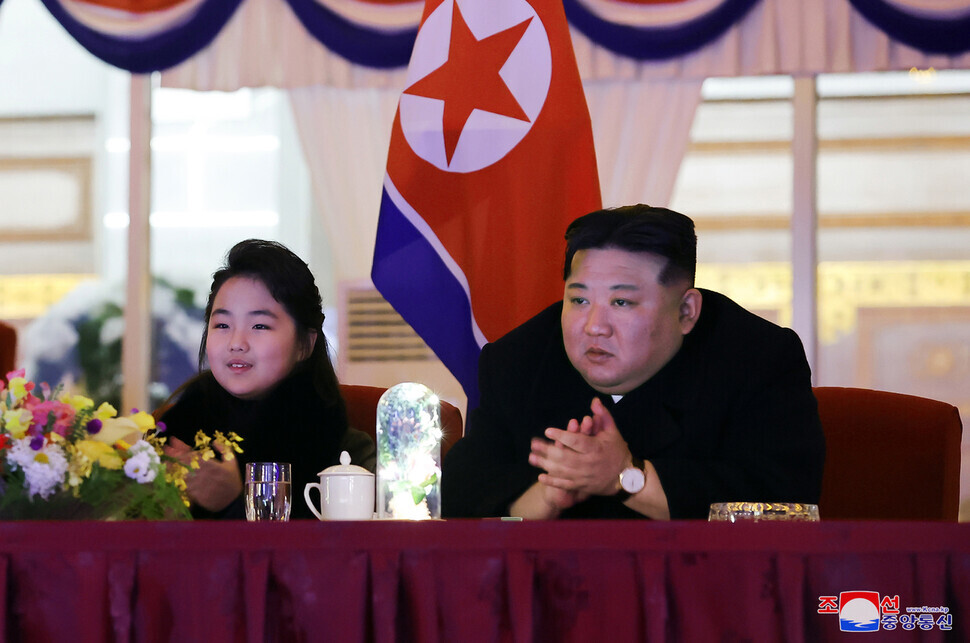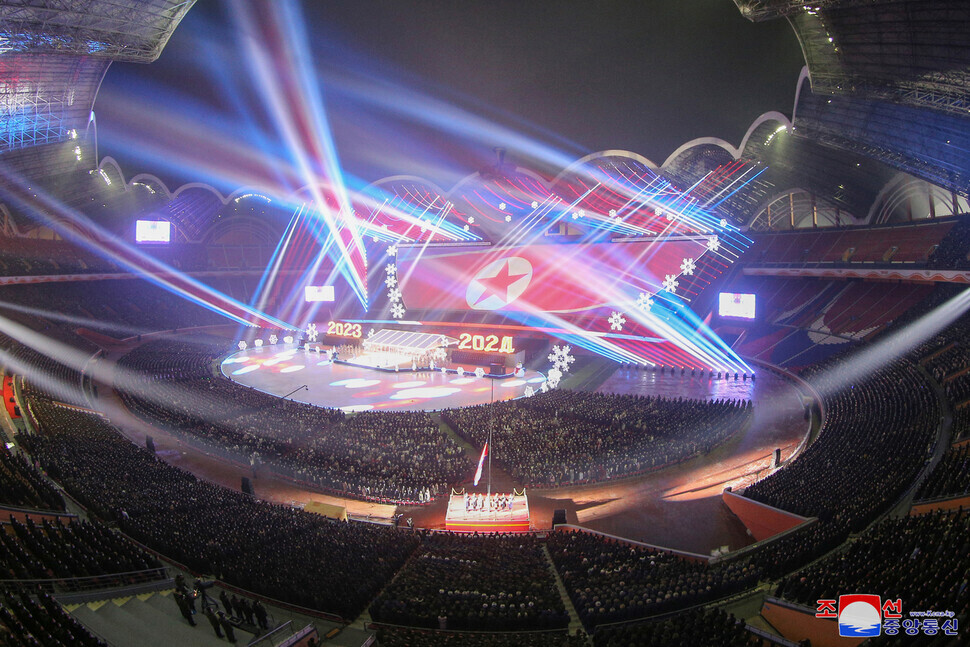hankyoreh
Links to other country sites 다른 나라 사이트 링크
[News analysis] Kim’s “two Koreas” rhetoric could be a strategy for avoiding unification by absorption

North Korean leader Kim Jong-un’s declaration that the relations between the two Koreas have become “fixed into the relations between two states hostile to each other” late last month at a gathering of the Workers’ Party of Korea has sent shockwaves across the peninsula.
The reason it’s made such a splash is that by stressing the necessity to take measures for “readjusting and reforming the organizations in charge of the affairs” related to South Korea, Kim’s remarks fly in the face of the Inter-Korean Basic Agreement (signed on Dec. 13, 1991), which defines inter-Korean relations as a “special interim relationship stemming from the process towards unification” rather than ties between two states.
Stripped of characteristically hostile tone in light of the deteriorating situation on the Korean Peninsula and domestic political demands, Kim’s “two Korea” rhetoric is a defensive strategy aimed at avoiding South Korea’s absorption of North Korea by force, a proposed tactic for reunification that the North has consistently been wary of in the post-Cold War era, senior experts on inter-Korean relations told the Hankyoreh on Monday.
Kim’s two-state theory isn’t a bolt from the blue. Rather, it is a full-blown formalization of the division strategy that Kim has been pursuing since taking power in 2012. The first step was implementing “Pyongyang Time,” which took place on Aug. 15, 2015, and set back standard time in the North by 30 minutes. This erected an institutional barrier to reunification, as it separated the Korean Peninsula’s time, which had been the same since the division of the country, into North and South. (Pyongyang Time was rescinded shortly after the April 27 summit in Panmunjom in 2018.)
The second phase of solidifying Kim’s “two Koreas” idea was the “our state first” principle, which first appeared in the state-run Rodong Sinmun in November 2017 and was officially proclaimed at the eighth Congress of the Workers’ Party of Korea in January 2021. This was significant in that he updated his father Kim Jong-il’s “theory of the Korean nation as No. 1” slogan to one that specifies the North Korean state, rather than the Korean nation.
This falls in line with Kim’s emphasis on “unity with patriotism” as the main “spirit” and idea of the most recent plenum.
During the eighth congress, in 2021, Kim lamented that “hope for national reunification has become more distant,” formalizing his two-state concept. Normally, Kim addresses inter-Korean relations as its own issue, separate from foreign affairs. At the time, however, Kim minimized the importance of inter-Korean relations by including it as just another part of foreign relations. He also revised the party’s bylaws by removing its duty to carry out a “national liberation and people’s revolution” and erasing phrases such as “unified development of the nation and our people.” Kim has essentially dismantled the party’s traditional ethnonationalist doctrine by discarding North Korea’s original strategy of revolutionizing South Korea.
Kim began accelerating his “division strategy,” or open hostility toward South Korea and inter-Korean reconciliation, in May 2022, when the Yoon Suk-yeol administration took power in South Korea. This was demonstrated on July 1, when Kim Song-il, a director general in North Korea’s Foreign Ministry, rejected a bid by the Hyundai Group chairperson to visit Mount Kumkang. Inter-Korean travel isn’t typically handled by the Foreign Ministry, as it traditionally has been considered a separate issue from international travel. For the Foreign Ministry to publicly and officially deny a visitation request from a major South Korean businessman was unprecedented.
Kim hinted at this most recent party gathering that he will disband the United Front Department, North Korea’s counterpart to the South Korean Ministry of Unification, and other state entities specifically tasked with inter-Korean relations, and simply reallocate their resources to the Foreign Ministry. This is part of a larger policy initiative for “readjusting and reforming” organizations in charge of managing affairs with South Korea. According to the state-run Korean Central News Agency, North Korean Foreign Minister Choe Son-hui held a meeting with Ri Son-gwon, the director of the United Front Department, and other state officials in charge of relations with South Korea on Monday to carry out these direct orders from Kim.
Kim blamed South Korea’s designs for “unification by absorption,” “unification under liberal democracy,” and regime collapse to justify his declaration that inter-Korean relations are now those of two hostile nations.
“If there is a common point among the ‘policies toward the north’ and ‘unification policies’ pursued by the successive south Korean rulers, it is the ‘collapse of the DPRK’s regime’ and ‘unification by absorption,’” Kim said, according to the KCNA. “And it is clearly proved by the fact that the keynote of ‘unification under liberal democracy' has been invariably carried forward although the puppet regime has changed more than ten times so far.”
Kim also identified “defending the dignity of the Party,” “raising the national dignity,” and “protecting the national interest” as the key principles of North Korea’s foreign policy. By “dignity of the party,” Kim is referring to himself and his family dynasty, the so-called “Mount Paektu bloodline.” Kim is often referred to as “the benevolent father of the great socialist family.” In other words, he will not stand for being absorbed by South Korea or for a regime collapse. The fear of “absorption unification,” or being absorbed by South Korea, is a longstanding concern of the North Korean regime. North Korean founder Kim Il-sung first coined the term during his New Year’s address on Jan. 1, 1988.
“The word ‘war’ is already approaching us as a realistic entity, not an abstract concept,” said Kim Jong-un. He clarified his hard-line stance toward Seoul by calling for preparations “for a great event to suppress the whole territory of south Korea,” saying it would counter the “frantic nuclear war threat racket and all-out confrontation of the US and its vassal forces with nukes and all-out confrontation.”

Kim used the phrase “war of justice for reunification” during a meeting of the Workers’ Party in May 2016. In December 2022, he described inter-Korean tensions as one of meeting force with force in an all-out contest for victory. Kim has therefore returned to his old rhetoric. Kim Il-sung called for an offensive military campaign for unification, while Kim Jong-un is now calling for what could be dubbed “defensive hostility.”
Regarding Kim’s “two Koreas” rhetoric and his hints that he won’t shy away from nuclear war, some observers are calling Kim’s strategy a “hedgehog approach,” meaning he’s shutting the gates and hunkering down in preparation for a long-term siege from the US and South Korea. But is that the case? Not quite.
It’s worth noting that the Rodong Sinmun reported that Kim and Chinese President Xi Jinping vowed to make 2024 a “year of DPRK-China friendship” in an exchange of New Year’s greetings on Monday. (DPRK stands for Democratic People’s Republic of Korea, the formal name of North Korea.) In this exchange, Kim proposed that the two countries “further deepen the ties of friendship and unity and intensify the cooperation in the joint struggle to safeguard regional and global peace and stability.” Xi responded by calling the new year an opportunity to “deepen strategic mutual trust, enhance exchanges and cooperation.”
“It’s highly probable that Kim will visit China this year for a North Korea-China summit,” said a former government official familiar with Pyongyang-Beijing relations.
Kim held a summit with Russian President Vladimir Putin in September 2023. By following up with a summit with Xi in 2024, Kim may seek to widen his backyard in global operations.
There is a legitimate concern that inter-Korean relations and Korean Peninsula geopolitics will deteriorate into a bottomless spiral.
“In spite of Kim’s ‘two Koreas’ rhetoric, we still need to relieve inter-Korean tensions and open a path for communication that leads to a road of peaceful co-existence and joint prosperity,” said the aforementioned government official.
“Right now, the most pressing issue is jumpstarting dialogue to prevent military clashes,” the official added.
By Lee Je-hun, senior staff writer
Please direct questions or comments to [english@hani.co.kr]

Editorial・opinion
![[Editorial] Yoon must halt procurement of SM-3 interceptor missiles [Editorial] Yoon must halt procurement of SM-3 interceptor missiles](https://flexible.img.hani.co.kr/flexible/normal/500/300/imgdb/child/2024/0501/17145495551605_1717145495195344.jpg) [Editorial] Yoon must halt procurement of SM-3 interceptor missiles
[Editorial] Yoon must halt procurement of SM-3 interceptor missiles![[Guest essay] Maybe Korea’s rapid population decline is an opportunity, not a crisis [Guest essay] Maybe Korea’s rapid population decline is an opportunity, not a crisis](https://flexible.img.hani.co.kr/flexible/normal/500/300/imgdb/original/2024/0430/9417144634983596.jpg) [Guest essay] Maybe Korea’s rapid population decline is an opportunity, not a crisis
[Guest essay] Maybe Korea’s rapid population decline is an opportunity, not a crisis- [Column] Can Yoon steer diplomacy with Russia, China back on track?
- [Column] Season 2 of special prosecutor probe may be coming to Korea soon
- [Column] Park Geun-hye déjà vu in Yoon Suk-yeol
- [Editorial] New weight of N. Korea’s nuclear threats makes dialogue all the more urgent
- [Guest essay] The real reason Korea’s new right wants to dub Rhee a founding father
- [Column] ‘Choson’: Is it time we start referring to N. Korea in its own terms?
- [Editorial] Japan’s rewriting of history with Korea has gone too far
- [Column] The president’s questionable capacity for dialogue
Most viewed articles
- 1Months and months of overdue wages are pushing migrant workers in Korea into debt
- 2Trump asks why US would defend Korea, hints at hiking Seoul’s defense cost burden
- 3At heart of West’s handwringing over Chinese ‘overcapacity,’ a battle to lead key future industries
- 4[Editorial] Yoon must halt procurement of SM-3 interceptor missiles
- 5Fruitless Yoon-Lee summit inflames partisan tensions in Korea
- 61 in 3 S. Korean security experts support nuclear armament, CSIS finds
- 7Dermatology, plastic surgery drove record medical tourism to Korea in 2023
- 8AI is catching up with humans at a ‘shocking’ rate
- 9First meeting between Yoon, Lee in 2 years ends without compromise or agreement
- 10Amnesty notes ‘erosion’ of freedom of expression in Korea in annual human rights report